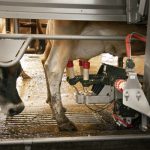Time of weaning will have an impact on cow and calf performance
ST. CLOUD, Minn. — We typically wean calves around six to seven months of age and in a typical spring calving herd that means October or November. However, during a drought when forage is starting to become limited, we should consider early weaning as a management tool. Time of weaning will have an impact on cow and calf performance as well as health and productivity of the native range or pasture. With the year we are having we might want to start looking at this as a possible option. With weaning early there are many advantages and disadvantages that can come with it. One of the greatest advantages that I see is that it will reduce the nutrient requirements of the cow. Lactation represents the greatest nutrient demand for protein and energy for the cows throughout the year. The easiest way to reduce those needs is to wean the calf. The dry cows will consume less forage (1/3 to ½) and you will not have the pressure on the pasture from the calves. So, the question becomes how early can I wean my calves? Research has been shown you can successfully wean beef calves as early as 45 days but it is to wait. Weaning March and April calves in late July or early August is generally preferred. You will need to provide an excellent health and vaccination program to ensure a successful weaning process for your calves. Some things to consider before weaning is to castrate, vaccinate, treat for internal and external parasites and to implant. You will want to do these before weaning to reduce stress. Bunk management for early weaned calves is also going to look a little different. Early weaned calves most likely do not have exposure to feed bunks like they might have later in the fall. It is a good idea to offer a creep feed 3-4 weeks prior to weaning to help the calves adjust to eating a processed feed. This will help make the weaning process go more smoothly. You will want to offer a long stem hay initially and top dress with a commercial feed or concentrate mix for the first 5 days. Once the calves are consuming these feeds, you can begin to offer a mixed ration. The other big thing to consider is your facility. These calves are going to be a lot smaller then when you typically wean so we must make sure the feed bunk and waters are at the adequate height.
Advantages
* Improved Body Condition
* Improved Calf Performance
* Improved Pregnancy Rates
* Improved Forage Availability for the Cow
Disadvantages
* Increased attention to management is required
* Increased cash costs
Please contact Stacey Caughey, Interim Extension Educator for Stearns, Benton and Morrison counties with any questions at 218-330-5737 or butle269@umn.edu
— University of Minnesota Extension
Last modified: 07/12/2020













